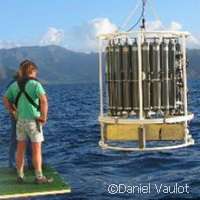Small bacteria helping big things grow in the ocean

Around 71 per cent of the Earth's surface is made up of salt-water oceans - that's 98 per cent of all water. The ecosystems that exist beneath their surface are diverse and vibrant. Their sheer scale, however, means that there is still a lot to be discovered. And that is exactly what an international team comprising scientists from Europe and the United States have done. Their new discovery - of a symbiosis between tiny single-celled algae and highly specialised bacteria in the ocean - will help scientists to better understand oceans and the important role they play in our lives.
The scientists discovered the important role that single-celled algae and nitrogen-fixing bacteria have in helping to fertilise the oceans by taking nitrogen from the atmosphere and transforming it into a form that other organisms can use. The details were published in the journal Science. Their discovery came about from past research into the investigation of a mysterious nitrogen-fixing microbe that has a very small genome.
This microbe was first detected in 1998 by Jonathan Zehr, a marine scientist at the University of California, Santa Cruz (UCSC). This microbe - which belongs to a group of photosynthetic bacteria known as cyanobacteria, but lacks the genes needed to carry out photosynthesis - is the most widespread nitrogen-fixing organism in the oceans. It now appears that its symbiotic relationship with the algae makes the need for those photosynthesis genes unnecessary.
'The cyanobacterium is a nitrogen-fixer, so it provides nitrogen to the host cell [the algae], and the host cell provides needed carbon to the cyanobacterium, which is lacking the machinery to get its own,' says Anne Thompson, a lead author of the paper and researcher at UCSC.
Matt Kane, programme director in the National Science Foundation's (NSF's) Division of Environmental Biology, which funded the research along with NSF's Division of Ocean Sciences, believes that the finding has uncovered a symbiosis between two types of microorganisms that had remained hidden until now.
'Genomic analysis indicates that the partnership between these organisms in some ways models the one that led to the evolution of plant organelles,' says Dr Kane
This is an interesting symbiosis from an evolutionary perspective, notes Professor Zehr, 'because it can be seen as analogous to an early stage in the endosymbiosis that led to chloroplasts in plants.'
Chloroplasts - organelles that capture light energy and carry out photosynthesis in all plants - evolved from symbiotic cyanobacteria that eventually were incorporated into host cells in a process known as endosymbiosis.
In previous work, Professor Zehr's team had studied the cyanobacteria in samples processed at sea and brought back to the lab. The researchers were able to sequence the microbe's complete genome. They discovered that it's missing the genes for several key metabolic pathways, suggesting that it might live in association with another organism.
The scientists were only able to see the symbiotic partners together when they sorted freshly collected seawater samples on board a research vessel.
'Our collaborators at the University of Hawaii, Dave Karl and Ken Doggett, put a cell sorter into a portable laboratory - a lab in a box - so now we can take the machine to sea and sort cells that minutes before were in their natural environment,' says Ms Thompson. 'That's how we found the association.'
Professor Zehr noted that it's difficult to estimate the contribution of this symbiosis to global carbon and nitrogen cycles. Other algae are more abundant and may be more important in terms of the ocean's carbon cycle than the algae hosts in this symbiosis, he says. But the cyanobacteria partners likely make this a significant contribution to global nitrogen fixation in the oceans.
'Planktonic symbioses are very difficult to study,' says Rachel Foster of the Max Planck Institute for Marine Microbiology, the other lead author. 'The associations are often fragile. Here we used multiple tools to identify one of the first examples of this kind of partnership in plankton.'
Journal information: Science
Provided by CORDIS

















